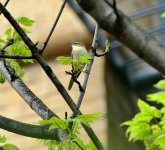foresttwitcher
Virtually unknown member

For reasons of Covid and changed personal circumstances my birding for the last couple of years has been restricted to my daily dog walking route in the Chilterns (SE England). This takes me through a small triangular area of ex-agricultural land that was isolated by the construction of a by-pass in the mid-80s. Bounded on two sides by housing on the edge of a market town and on the third by a road with arable fields beyond, this patch has scrubbed over naturally and become a good area for warblers (and other birds) - Chiffchaff, Blackcap, Common & Lesser Whitethroat and Garden Warbler.
Being in the Chilterns and on chalk there is no wetland habitat anywhere nearby, not even damp ditches. The nearest water of any kind is a small but 'urbanised' chalk stream flowing through the town, generally with no suitable vegetation, which is at least half a mile away and a man made lake, with some reeds and marginal vegetation, over a mile away.
For each of the last two springs I have had 1 day singing Sedge Warblers, which I assumed were recently arrived migrants that had put down in the scrub to feed up and prospect for suitable habitat but which had moved on shortly afterward.
This morning there was a bird singing in a dense area of tall umbellifers surrounded by blackthorn & hawthorn scrub. Is it in any way usual to find a Sedge Warbler this far away from water or wetland outside the migration season?
Being in the Chilterns and on chalk there is no wetland habitat anywhere nearby, not even damp ditches. The nearest water of any kind is a small but 'urbanised' chalk stream flowing through the town, generally with no suitable vegetation, which is at least half a mile away and a man made lake, with some reeds and marginal vegetation, over a mile away.
For each of the last two springs I have had 1 day singing Sedge Warblers, which I assumed were recently arrived migrants that had put down in the scrub to feed up and prospect for suitable habitat but which had moved on shortly afterward.
This morning there was a bird singing in a dense area of tall umbellifers surrounded by blackthorn & hawthorn scrub. Is it in any way usual to find a Sedge Warbler this far away from water or wetland outside the migration season?





